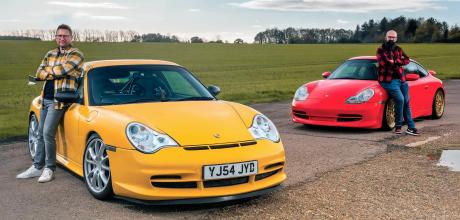2004 Porsche 911 GT3 996.2 vs. 3.7-litre 1999 911 Carrera 991.1
We’re lucky enough to have not one, but two 996s on our fast fleet. They might be cut from the same cloth, but make no mistake, these are two very different examples of the first water-cooled 911...
Words Dan Sherwood and Seán Matthews
Photography Dan Sherwood
CUT FROM THE SAME CLOTH
996 GT3 MEETS RENNELEVEN 3.7 981 GT4 FUN WITH MODIFIED MODERN CLASSICS
2004 Porsche 911 GT3 996.2 vs. 3.7-litre 1999 911 Carrera 991.1
DAN SHERWOOD 996 GEN II GT3 DOUBLE ACT OUR FAST FLEET

I CAN LEAN ON IT MORE THAN I THOUGHT I’D BE ABLE TO, ALL THE WHILE KNOWING I’M NOWHERE NEAR THE LIMIT OF THIS CAR’S CAPABILITIES
Though often far removed from the confusing world of algebra, arithmetic and geometry many of us struggled to wrap our heads around in school, an innate ability to use man maths when weighing up financial decisions seems to be hard-wired into every male-born being. The phenomenon is used in all areas of life, but perhaps none more so than when debating the viability of a new motoring purchase. A perfect example of this mathematical anomaly in action is where a car — or often an additional car — is bought, with the very real intent of either saving or making money. To a petrolhead’s significant other, this scenario can seem borderline insane, but looked through the lens of man maths, all becomes crystal clear and utterly infallible. This was the very situation I found myself in when handing over the money to purchase my very first Porsche a few months ago.
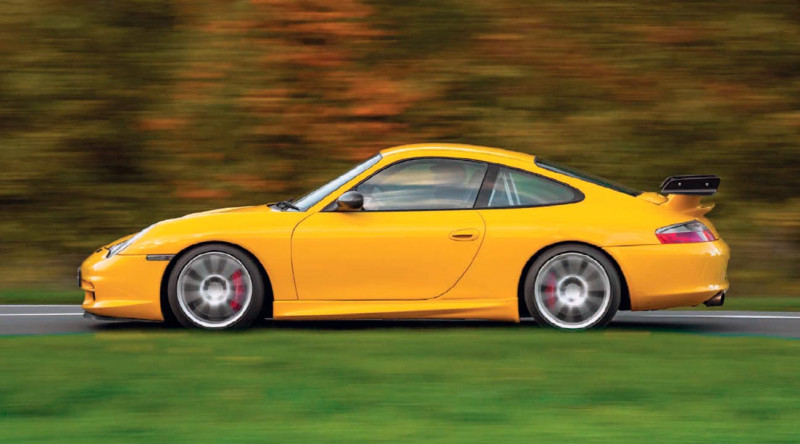
Having worked as a photographer for this fine tome for many years, I was used to pointing my lens at Stuttgart’s finest fare, but I’d never dipped my toe into the well of ownership. I’d long debated the issue — what better way to truly understand and get ingrained in the culture of the subject of your art than to practice what you preach? Sadly, the right car, the right time and, most importantly, the right price, always seemed to elude me. “What changed?” I hear you cry. “Why splash out now, on the brink of global recession?!” Well, this is where man maths enters the fray.
SPECIFICATION WAS LEFT ALONE FOR A YEAR AND THE CAR WAS ENJOYED AS OFTEN AS COVID RESTRICTIONS WOULD ALLOW
After receiving a chunk of equity from a recent house sale, but subsequently realising I wasn’t in a position to purchase another property, I had a veritable furnace burning a sizable hole in my pocket. Not a terrible problem, I’ll give you, but with the current cost of living crisis and inflation pushing prices of, well, everything into the stratosphere, my savings were effectively eroding before my eyes. I needed to invest to retain my capital.
Without a background in the likes of the stock market, art, watches or the latest and greatest crypto currency to fall back on, I felt the best thing was to play to my knowledge base and emphatically ignore the many people who advise never to invest in cars. And so, the search for a suitable motor was on. A Porsche seemed the obvious candidate, both from a financial standpoint, as well as in terms of smiles-per-mile.
I wasn’t interested in buying just any Porsche, though. It needed to be one that would increase its value. At worst, it had to maintain its financial worth, even after I’d enjoyed plenty of seat time. When questioned, the many specialist Porsche dealers and tuning houses I came across on my travels all arrived at the same conclusion: the 996-generation 911 GT3 was the car to buy.
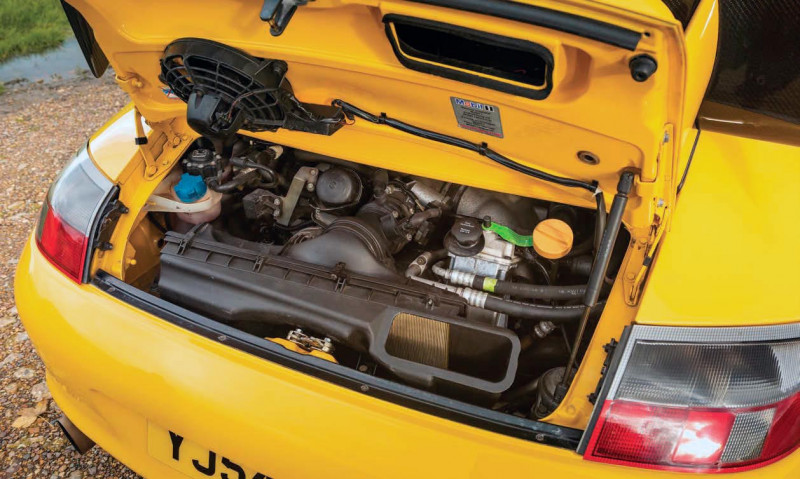
Their reasoning seemed sound. As the model heralding the introduction of the water-cooled era of 911 production, plus a more slippery body shape and deviation from the traditional oval headlights to those ever-so-subjective ‘fried eggs’, the 996 had suffered a pretty bad rep in Porsche circles following model launch, with many enthusiasts feeling it was too radical a departure from the air-cooled cars they had grown to love and respect. Add in the M96 engine’s reputation for mechanical failure and, for many years, you could pick up a 996 at a bargain price. The GT3 variant, however, suffered none of the reliability issues of its siblings, thanks to the use of the excellent competition-proven ‘Mezger’ dry-sump flat-six derived from the 962 and GT1 endurance racers. Even so, this wasn’t enough to stop the 996 GT3 being tarred with the same brush as its Carrera-badged stablemates, resulting in values remaining relatively stagnant while prices of other GT-badged Porsche models, including the later 997 GT3, had long since shot through the roof.
Introduced in 1999, the 996 GT3 (the first GT3-badged 911) was devised as a homologation model for cars entered in the FIA GT3 Cup. Based on the stiffer Carrera 4 shell, this motorsport machine was more akin to the RS models of yore, with many components chosen for their suitability for racing, rather than for their appropriateness for use on the public highway. This led to items such as sound deadening and the rear seats being deleted. Luxuries, such as a radio and airconditioning, were installed on customer request as no-cost options.
Lowered and re-tuned suspension, uprated brakes, lighter wheels, a downforce-inducing front bumper, side skirts and a swoopy rear spoiler identified the GT3 from its more roadbiased brethren. The optional Clubsport trim added bucket seats, harnesses and a half-rollcage to the mix, along with a lighter single-mass flywheel and a fire extinguisher in the passenger footwell. Those troublesome fried eggs remained, though. Critics bemoaned they too closely linked the GT3’s likeness with the entry-level Boxster. Things would change with the launch of the facelifted 996 GT3, launched in 2004. The model swapped its predecessor’s eggy ‘eyes’ for the more hawkish lights from the facelifted 996 of 2002. A new front bumper and less flamboyant (yet more functional) rear wing also marked the new arrival out from its forebear, while ten-spoke wheels hid more powerful six-piston calipers at the front. The flat-six, meanwhile, saw a host of upgrades increasing output from 355bhp to 381bhp.
In my eyes, the later 996 GT3 has the edge over the original, both in terms of performance and aesthetic presence. Plundering the classifieds, my heart began to sink when I saw only a handful of second-gen survivors for sale, all of which had price tags placing them squarely out of my reach. Many of these cars were pampered garage queens with scandalously low mileages and had obviously been bought more for their investment appeal than for the love of driving, but whether they were low mileage minters or seasoned track machines, the trend in values remained consistent, with the asking price of all 996 GT3s slowly but surely increasing over the previous twelve months.
It was at this point I considered I was aiming too high and should set my sights on a more affordable 911. I was contemplating ownership of a 996 Carrera 4S, but none of the cars I saw presented either the emotional thrill or potential financial reward I saw in the GT3. I kept looking.
It was around this time Porsche released the 992 GT3 RS, which wowed the motoring press with its otherworldly performance and wild aero-derived looks. I was also aware of the new LMGT3 class scheduled for next year’s World Endurance Championship.
Add in this year being the 911’s sixtieth anniversary and it becomes clear interest in Porsche’s race-bred models will soon be reaching fever pitch. It really was a case of ‘now or never’ if I was to get behind the wheel of a GT3 before even the 996 variant fell into the realms of unobtainium. And then it appeared. Resplendent in the eyepopping shade of Speed Yellow, a 2004 996 GT3 was offered for sale and, to my amazement, was within my price range. It’s thought only 141 right-hand drive 996 GT3s were imported into the United Kingdom by Porsche Cars Great Britain. A low number of these cars were finished in the lurid buttery hue, which in my opinion, is the best colour for this tracktuned flying machine.
NUMBER CRUNCHER
With 78,000 miles on the clock, many of which likely accrued while being driven on track, this GT3 was a little leggier than other examples I’d seen, but the car’s use was completely commensurate with that which it was built for, a theory confirmed by extensive service history littered with receipts from well-known marque specialists, including Autofarm, Cath Burrows, HP Porsche and Ninemeister. The paperwork highlights how the car was always prepared and ready for circuit action with whatever servicing and upgrades were deemed necessary.
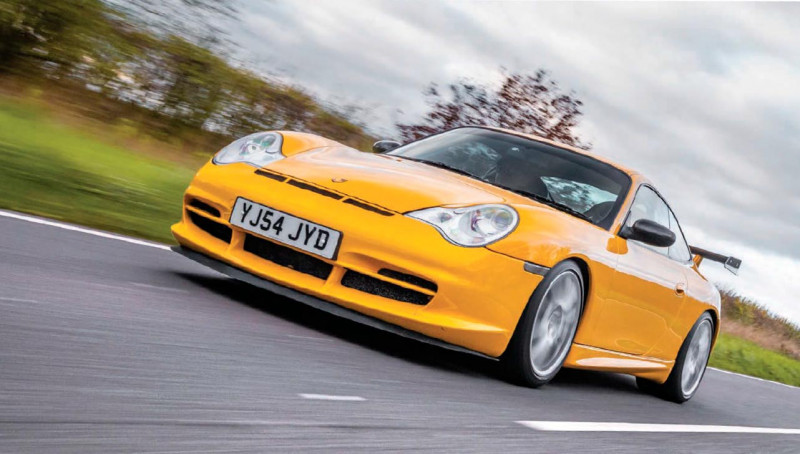
Aside from the stunning colour, which is shielded with a layer of paint protection film, the front bumper had been swapped to a vented RS item, while the larger carbon rear wing blade is also a Rennsport part. These not only give the car a more hardcore look, but add extra downforce at speed.
What wasn’t instantly obvious was modification under the skin. The GT3’s suspension is already firmer and lower than that of the Carrera models, but this particular 911 had been treated to a set of KW’s excellent Clubsport adjustable coilovers. Additionally, the beefy six-pot front brakes house a set of Pagid RS29 pads clamping onto uprated Alcon rotors. The rear limited-slip differential has been upgraded with a G50 carbon-fibre unit, while the gearshift has been improved with Cup-spec linkage and cables. Opening the driver’s door reveals a genuine Porsche Tequipment stainless steel half-rollcage, as well as Scroth five-point racing harnesses adding to the circuit-slaying drama, an effect enhanced by the steering wheel, recently retrimmed in Alcantara. This was exactly the car I’d been looking for: one that could be used, abused, pampered and improved, all at the same time.
It was offered at a price reflecting its slightly elevated mileage, but with plenty of scope to either retain that value or (hopefully) see it rise as the market for these models gathers pace. Either way, my plan for the car was not just to maintain the standard, but to improve as best I could, an endeavour which could be followed in these very pages.
There I was, signing away more money than I’d ever spent on something that didn’t come with a kitchen, bathroom and a tiled roof. It was a nervous moment for sure, but buying through respected Porsche restoration and sales specialist, Rindt Vehicle Design, gave me reassurance. Besides, my trusty man maths had convinced me this was the right move.
Payment made, the car was mine. It was a surreal experience to slide into the black leather wing-back buckets for the first time, knowing I wouldn’t have to give this 911 back at the end of the day. A feeling heightened further the first time I twisted the ignition key and fired the engine to life. Having recently been serviced by the Rindt team, the 3.6-litre flat-six roared to life before settling to the trademark spritely and clattering idle. Gripping the wheel and feeling the texture of the nap on my fingertips, even before I’ve moved an inch, the GT3 felt utterly alive. Unlike air-cooled 911s, where the pedals are wildly offset in a right-hand drive example and the whole seating position completely alien to anyone who hasn’t previously experienced this ergonomic idiosyncrasy, the 996 felt ‘right’ straight from the off.
When the engine had warmed slightly, I pushed the stick forward and engaged first gear. The shift was slightly longer than expected, but felt very precise and slotted home with satisfying weight. The clutch was as heavy as you probably imagine it to be, but was no worse than many other high-performance sports or race cars I’ve driven with a manual gearbox. Just pulling away, the GT3 felt special — easy to drive at low speed, but with the feel of being behind the wheel of a race car aching to be let off the leash. Finally out on the open road, it was time find out what the fuss is about when it comes to GT3-badged 911s.
Having been in the hot seat of a number of fast cars over the years, including Porsches, I’m no stranger to speed, but this was my first time experiencing a drive in a Porsche of my own — there’s nothing quite like jumping in at the deep end! Before I opened the throttle fully, I could sense this was a car built with purpose. Every control is razor sharp, from the throttle response to the steering, with even a millimetre of travel on the accelerator equating to a noticeable change in velocity. But now was the time.
As a series of fast, open sweeping bends lay out in front of me, I smashed my right foot to the floor and let the rev counter needle whip around the dial and bury itself into the redline. The sound was simply astonishing, with the metallic wail of the normally aspirated engine unlike anything I’d heard before. Accompanying the noise was immense thrust, which pinned me into the supportive bucket seats and repeatedly fired me at the snaking tarmac, gear after gear.
The precise steering gave feedback in abundance, which if you’re not used to, can feel a little sketchy at first, but I soon learned to trust in the incredible levels of grip on offer — helped in no small part by Rindt’s decision to fit fresh Michelin N-rated rubber prior to my purchase — and simply let the wheel writhe and jink in a loose grip, the GT3 guided by my palms. The KW coilovers are definitely set a little lower than stock, and a rogue deep compression saw the front splitter skim the black top, but although firm, the suspension remained compliant enough to see speeds rise confidently into licence-losing territory.
After a while at the controls, my initial nervousness subsided (even if the adrenaline hit remained) and I began revelling in the GT3’s ballistic crosscountry pace. It wasn’t the outright speed or even the eye-popping braking power that impressed me most — it was the complete package of pace, steering, suspension and braking, as well as that undefinable quality of simply feeling ‘special’, an excitement experienced every time I get behind the wheel or even when I look back at the car after climbing out of the cabin.
It’s the feeling you’re driving something out of the ordinary. For me, this is the most exciting aspect of GT3 ownership. Yes, I’m hoping my man maths will prove fruitful in the long term, but for now, I’m going to focus on enjoying every moment I have with this car. I intend to make memories that will last a lifetime. Expect to be reading about them in forthcoming issues of the magazine.
SEÁN MATTHEWS 996 CARRERA
I would like to discuss an affliction I have. I’m fortunate insofar as the complaint is understood by many — it’s something other people are suffering right now. I’d go as far as saying it has become something of an epidemic in Porsche circles. My illness? I own a 996-generation 911. Yes, the crap one, as I have heard naysayers state when I tell them which 911 is parked on my driveway. The very model plagued by intermediate shaft bearing (IMS) issues. The Porsche which shared the majority of parts with a lesser model. The one with those headlights.
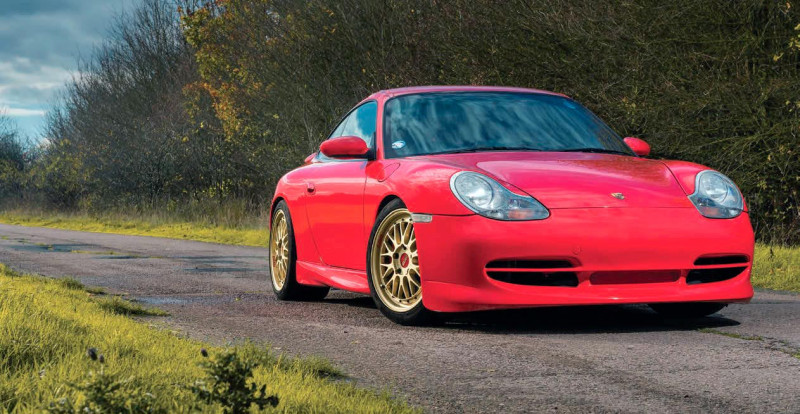
Despite these uncomfortable truths, the 996 is, in my opinion, the best 911. I was infected with this disorder in my youth. It was 1997 and I was fortunate to grow up in Weybridge, a small town in Surrey. Eye-popping performance cars populated the suburban roads. My walk home from school most afternoons was regularly made more entertaining by a familiar shape darting past.
It was recognisable in as much as I was clearly looking at a 911, but the front end of this car looked sleeker and smoother than the Porsche in my mind’s eye. In many ways, the Surrey speed machine looked like a concept car. It was beautiful, a mobile work of art. It was an early 996 Carrera and I was hooked.
A decade ago, the 964 was the Porsche to buy as a future investment. Prices started picking up and I was caught up in the buzz. A Guards Red manual Carrera 4 with black leather soon presented itself. The seller wanted ten grand. I hesitated, thinking about the lack of garage space at my disposal. Less than thirty minutes later, the car was sold. The nine-one-one that got away. This procrastination has haunted me for years.
My appreciation for G-series 911s hadn’t yet matured, and though they were widely regarded as the affordable entry point to 911 ownership, my life moved on — family commitments meant I had to forget about buying a Porsche. The viral infection, so I thought, was lifting, but magazines were labelling the 996 a future classic. Moreover, motoring media confirmed the first water-cooled 911 wasn’t as bad as so-called Porsche purists had been saying. Of course, those aware of how good the 996 is also recognized the fact it wasn’t just the more expensive Carrera 4S, Turbo or GT variants which were starting to gain appreciation among a new generation of Porsche fanatics.
Even with a house purchase threatening to put paid to the opportunity of owning a 911 until much later, my sickness returned. A plan was already formulating for the 996 I would search for when funds allowed. I was adamant specification needed to include Guards Red paintwork, sunroof delete, factory aero kit, black leather, manual transmission and rear-wheel drive. These were the non-negotiables. Fast-forward to the present and I own the very 996 I dreamed of. It’s the car you see here. If it looks familiar, this is likely because my early adventures in Porsche ownership have been documented richly in this publication’s monthly ‘fast fleet’ pages.
As you can probably tell, the car isn’t in the same specification it left the factory in 1999. You see, another ailment I suffer from is not being able to leave cars as they rolled off the production line — I have yet to own a vehicle I haven’t modified. I can’t help it! I firmly believe each car is a blank canvas waiting for me to improve upon. Is my 911 to everyone’s tastes? Do I care? In a world where other people’s opinions are forced on us at every turn, I like the fact my car is just that: my car.
The suspension work was carried out by a local specialist. Whilst having Bilstein PSS10s placed under the arches, I had an RPM Technik CSR lightweight flywheel fitted, as well as a new clutch. A new aftermarket IMS bearing was installed as a precautionary measure, and then off I went to have geometry tweaked by Chris Franklin and Pete Leason at chassis tuning concern, Center Gravity. The pair lowered the car’s ride height past first-gen 996 GT3 levels and made my 911 handle like a Porsche should.
It looked brilliant hunched over its Speedline wheels, but still not how I imagined. Truth be told, I considered the car’s overall appearance not dissimilar from that of any other lowered 996. Talking fashion for a moment, a shoe can make or break an outfit, meaning you can never have enough footwear in your wardrobe. The same goes for wheels on a Porsche — choosing the right rims will change your car for better or worse. I wanted my Guards Red Carrera to stand out against all others, which is why I had to look beyond the UK’s shores for wheels. I could have saved myself a heap of hassle and fitted Fuchs reps, OZs or factory alloys from a 911 of similar vintage, but I was on the hunt for something different from the 996 norm.
It was while scanning the listings of eBay USA I happened across a set of ultra-rare, eighteen-inch BBS LM F1 Championship wheels. Amazingly, they were fitted to a Guards Red 996 in Thailand and were in GT3 fitment. Fate, eh?! Money was exchanged and, within a week, the wheels were in my possession. I promptly bagged N-rated Michelin Pilot Sport tyres (285-section rears, 225 fronts) from my local Costco. Boom! Tony Stark’s chariot was ready. After all, red and gold is for life, not just for Christmas.
Front bumper smoothing was carried out by Colourkraft in Wellingborough, giving the aero kit lines a chance to breathe. With that, specification was left alone for a year and the car was enjoyed as often as COVID restrictions would allow. During periods of lockdown, however, I began to wonder how my 911 would behave on a track. My desire to modify was about to become far more pronounced, as demonstrated when I took the car to Northampton Motorsport, where race car preparation specialist, James Hatfield, amended geometry to accommodate standard 996 GT3 camber and toe. He also added a further five millimetres to the drop at the front, providing a touch more rake, making the car look that little bit more purposeful.
Next, I spoke to Chris Wright of Wallingford-based Porsche tuner, Wrightune. We agreed on the installation of a Wavetrac limited-slip differential to help in corners, as well as an RPM Technik CSR clutch friction plate, serving as a better match for the previously installed CSR flywheel. To keep things solid at the back, Rohler semi-solid engine mounts were bought from independent Porsche parts retailer, Design 911.
SHIFTING GROUND
To stop the car more efficiently and to reduce the risk of boiling the brakes, lightweight Girodisc two-piece rotors, Pagid Blue pads and a set of Wrightune’s own braided brake hoses (new to market at the time of installation) were fitted. I also wanted to improve feel when changing gears, ensuring I never mischange in anger — the 996 is notorious for having a wobbly gear knob due to the plastic parts within the linkage becoming loose. I sought assistance from Numeric Racing and the company’s incredible shifter and race cable combo, which not only reduces throw, but gives the ‘snickety’ feeling you would expect for the focused 911 I was creating.
Whilst the car was with Chris at Wrightune, I wanted him to investigate a strange whirring sound coming from the rear of the car, near the gearbox. It was plaguing my enjoyment behind the wheel. He came back to me with his diagnosis: the IMS bearing was on its last legs and had caused metal and plastic to find its way into the sump. The engine was only a few revs away from catastrophic failure! You’ll recall I paid a local indie to fit a new upgraded IMS bearing. I was shocked to discover the company had taken my cash, but hadn’t done the work, resulting in the situation I found myself in. After a frank conversation with the owner of the business, I explained how I wanted him to cough up the money to pay for a full engine rebuild. You’ll note I wasn’t asking him to overhaul the poorly flat-six — there was no way I was prepared to let him or his team touch my car ever again.
Thankfully, after a fair amount of back and forth, my demands were met. With money in hand, I visited Track Club in Kimbolton. This company is well-known for looking after Porsche race cars and offering pit lane support. During COVID, with a lack of motorsport to focus on, company boss, Stephen Docherty, decided to venture into engine building for road cars. I approached him and we talked about the best course of action for my 996.
Now, we could have put the failing boxer back together as a 3.4-litre unit and be done with it, but you know only too well I have a sickness: when we can do more, and get a little silly in the process, we must. Well, I must, but I’m sure some of you are as disturbed as I am with this modifying bug! We decided to give the car bigger lungs by way of more air in and out of the engine. To achieve this, Stephen installed an IPD Plenum, a modified throttle body (due to being an early cable throttle 996), equal length manifolds and an X-pipe mid-section with 200-cell catalysts courtesy of exhaust manufacturer, Top Gear. The car already made use of a Top Gear sports exhaust system and I wanted the new parts to be from the same brand.
During the engine rebuild process, an updated EPS IMS bearing was fitted. Additional modification included Westwood ductile iron enlarged piston sleeves with 100mm Mahle forged pistons. This gave the car a healthy capacity increase of 300cc, promising better midrange push. Yes, I now own a 3.7-litre 996 Carrera. Oh, and an impromptu gearbox rebuild was completed by the team at RPM Technik. The unit was grinding worse than teens in a skate park!
Following the engine and gearbox rebuild, and with 1,500 soft miles under its belt, it was time to give my perfect Porsche some welly. Wow! Why bother with any other 911 when the 996 can sound and go as good as this?! The gear change is the slickest this side of a Cup car and throttle response is sharp. And the grip and confidence the Wavetrac diff brings is nothing short of incredible. I can lean on it more than I thought I’d be able to, all the while knowing I’m nowhere near the limit of this car’s capabilities.
The engine sounds ravenous from 3,500rpm all the way up to the 7,200rpm redline and I get great push from any gear in the mids. The ECU hasn’t yet been remapped to take account of all the upgrades and additional displacement, meaning there’s a massive amount more to come from the car, but in the here and now, I can report blistering performance. The brakes are inspiring, providing lots more stopping power compared to the standard setup. Aesthetically, they look the mutt’s nuts peering out from behind the gold BBS multi-spokes. I suppose this is my representation of what a 996 Carrera Clubsport could have been — a capable coupe which can excel in B-road blasting, sensible commuting, a leisurely drive to the coast and, as I intend to discover, trackday work.
What’s next? Surely I’m done changing the car? Not likely. I enjoy this infection! At the time of writing, my 911 is in the capable hands of Pennings, a body shop in Milton Keynes, where the Porsche is about to undergo a full bare metal respray. I’m also having unhealthy thoughts about changing the interior. I like GT3 seats. I also like Recaro Pole Positions. As most people say, track days are a slippery slope. Will I go a bit mad on the chassis after catching another car-cold?
Watch this space. Every journalist raved about the 996 when these cars were new. Some of those writers own a 996 today, despite access to newer, faster metal. As for the headlights, which I consider a work of art, when you’re inside the car, you can’t see them, so no reason to get hung up. And there, in the driving seat, you’ll immediately see why it’s easy to succumb to the disorder that is 996 ownership. Give in to it and we can help each other in infecting the rest of the world.
Above As tidy as this modified Carrera is, Seán is treating it to a bare metal respray. Above Smoothed front end highlights just how slippery the 996’s bodywork is Below Engine has been increased in capacity to 3.7 litres following a rebuild
Above Carrera cabin is a comfortable place to be, though Seán is considering installing buckets Below Seán was adamant he wanted a rear-wheel drive, manual 996 Carrera with an ‘ironing board’ fixed rear spoiler.
Above An excellent example of how the GT3-aping Aerokit can make an entrylevel 996 Carrera look super-aggressive Below Gold BBS set against Guards Red paintwork delivers the full ‘Iron Man’ effect.
Above and below Heightened interest in Porsche’s GT3 lineage has seen prices of early models rise significantly during the past two years.
Above Not likely to let you slide around during cornering Below Man maths was largely responsible for Dan buying the GT3, which he acquired from Rindt Vehicle Design.
Above Speed Yellow is one of Porsche’s best colours and suits Dan’s GT3 to a tee Below Genuine Tequipment stainless cage populates the rear cabin and serves as a harness bar for Schroth safety belts
PAPERWORK HIGHLIGHTS HOW THE CAR WAS ALWAYS PREPARED FOR CIRCUIT ACTION WITH WHATEVER SERVICING AND UPGRADES WERE DEEMED NECESSARY
Above and below RS parts, coupled with trick chassis upgrades not limited to KW coilovers and Alcon brakes, hint at the car’s regular track use under the former owner’s rule Previous spread True 911 fans dress like their cars, right?


